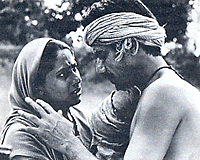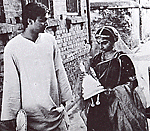Spotlight for Summer 2000:
Restoring the Classics
From time to time our customers ask us why a particular video that they
have rented is in such "bad" condition. We always try to get the best
quality that we can, but this is not always possible, especially with the older and rarer
titles that we carry. (And of course, with all "bad" tapes, there is
always the possibility that the customer merely needs to have his or her machine cleaned
or needs to adjust the tracking; often this will remedy the perceived problem.)
First of all, we try to determine whether the problem lies within the
videotape itself (in the individual cassette). Has it been damaged, is it dirty or
is it simply worn out? Lifting the sidebar that covers the tape will often reveal
waviness or lines, a sure sign that the tape is kaput. In this case, the solution is
simply replace that particular copy by ordering another.
The next step is to determine whether the film to tape transfer has been
poorly done. We can sometimes remedy this problem by ordering another copy, but with
some of the companies with which we deal (especially for rare and out of print films like
Werner Herzog's Cobra Verde or Hans Jurgen Syberberg's Our Hitler), the
level of quality control is very low and we take whatever we can get, often with foreign
language subtitles (in the case of our copy of Orson Welles's Falstaff, which is
subtitled in Japanese!).
Finally, we often have to admit that the original film print itself (from
which the videotape copy was struck) is at fault. This is much more difficult (if
not impossible) for us to do anything about. In fact, it is a sign of a more
depressing situation that exists for all of us who love the cinema, which is the rapid
deterioration of some of the world's finest films to the point of no return.
The scenario is this. If there are limited prints of a particular
film, and those prints have deteriorated, whatever copies are made from those prints will
be poor, no matter how good the videotape copying technology.
For example, we had in the store for a number of years very poor quality
video copies of the classic films of East Indian director Satyajit Ray, all from
"reliable" video distributors. Yet due to the overwhelming lack of popular
interest in Ray's films (in addition to bad storage techniques), the  original prints had so badly deteriorated that the black
and white images were almost indistinguishable from the background and the subtitles were
completely unreadable. The whole thing was just a big blur, compounded by poor sound
quality (again, a result of a deteriorating film print). And nothing could be done
to remedy the situation on our end. But, because of Ray's importance, we chose to
carry these films, albeit with a warning on the box to customers. Some of the more
diehard cinephiles were delighted that they had the chance to see these "lost"
masterworks. Others were not so understanding and kept wondering why we couldn't
just get another copy. But the problem was, there WERE no other copies; that is,
there were no other original film prints in existence from which video copies could be
made. original prints had so badly deteriorated that the black
and white images were almost indistinguishable from the background and the subtitles were
completely unreadable. The whole thing was just a big blur, compounded by poor sound
quality (again, a result of a deteriorating film print). And nothing could be done
to remedy the situation on our end. But, because of Ray's importance, we chose to
carry these films, albeit with a warning on the box to customers. Some of the more
diehard cinephiles were delighted that they had the chance to see these "lost"
masterworks. Others were not so understanding and kept wondering why we couldn't
just get another copy. But the problem was, there WERE no other copies; that is,
there were no other original film prints in existence from which video copies could be
made.
Which brings us to the issue of film restoration. In the case of the Ray films,
we can thank Ismail Merchant and James Ivory (the production team that has given us such
great contemporary films as A Room with a View and Maurice) for their
patient work to restore, frame by frame, all of theoriginal Ray film prints. This is
a process that takes place in the labs, using the newer digital technology (similar to
restoring old audio recordings, removing the scratches and rebalancing the treble and bass;
it is extremely time consuming and very expensive, which helps to explain why all of our
favorite films have not yet been restored). The results are so pristine that it
looks like the films were shot yesterday. These films (which also include
easy-to-read subtitles) are now a joy to watch, and it is an absolute miracle that they
have been saved. What a great legacy for Merchant and Ivory to acknowledge Ray as
their predecessor and pay him this tribute! (We only wish Terry Gilliam would take
some of the profits from Twelve Monkeys and restore Chris Marker's amazing La
Jetee, which he cites in the film's prologue as his inspiration.) rebalancing the treble and bass;
it is extremely time consuming and very expensive, which helps to explain why all of our
favorite films have not yet been restored). The results are so pristine that it
looks like the films were shot yesterday. These films (which also include
easy-to-read subtitles) are now a joy to watch, and it is an absolute miracle that they
have been saved. What a great legacy for Merchant and Ivory to acknowledge Ray as
their predecessor and pay him this tribute! (We only wish Terry Gilliam would take
some of the profits from Twelve Monkeys and restore Chris Marker's amazing La
Jetee, which he cites in the film's prologue as his inspiration.)
Which brings up the question of what we all can do to help. The Film Preservation
Foundation was created by Congress in 1996 in order to restore some of most important
films of the century. Films from this important program toured the U.S. this past
year in order to educate film lovers about how much work still needs to be done.
Thanks to the Foundation's efforts, we will soon have a restored version of the much
requested film El Norte (which has long been out of print on video and
unavailable in all but the poorest film prints). To contribute, please contact the
Foundation at www.filmpreservation.org.
Hopefully, with the move towards more advanced recording techniques (such as DVD),
conditions will improve and more restoration will be  undertaken BEFORE transfers are made. But
the sad fact of the matter remains that our valuable videotapes (and disks) can only be as
good as the film prints from which they are made. So go back and take a new look at
the restored Apu Trilogy and see for yourself how important it is to save all beautiful
films before they are lost forever. undertaken BEFORE transfers are made. But
the sad fact of the matter remains that our valuable videotapes (and disks) can only be as
good as the film prints from which they are made. So go back and take a new look at
the restored Apu Trilogy and see for yourself how important it is to save all beautiful
films before they are lost forever.
Next spotlight: French Films
|

